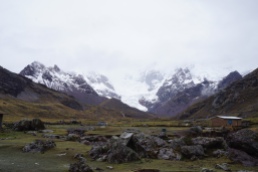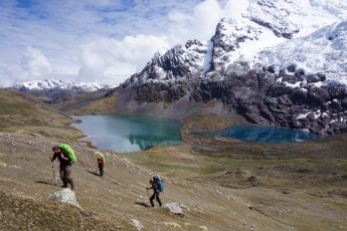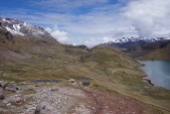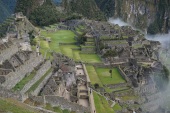As Gitte had already been to Peru some years ago, we decided on a few top things to do, and then intended to continue to Bolivia as soon as we could. However, as Peru is a big country — we travelled more than 3500 km by bus — it ended up taking us a while anyway. 😉
Arriving from Ecuador we spent the first day travelling by bus through vast deserted areas. After hours and hours of buses we finally got to Lima, where we spent a few hours sightseeing before we again boarded a bus to Huacachina. And that was were the fun began!
Huacachina is a small oasis town located between huge sand dunes. It has become a huge tourist draw, with literally hundreds of cars ready to take you into the dunes, and we learned that there are no natural water source filling the oasis anymore — meaning that the oasis is artificially maintained to keep the tourists coming. 😉 We spent a day on foot admiring the enormous amounts of sand and the amazing sunset that the landscape creates.
From Huacachina we boarded another night bus — our 4th night bus in 8 days — towards Cusco. Cusco is one of few cities that is built as a mix of the Inca structures already existing when the Spaniards arrived, colonial buildings, and modern day rebar concrete structures. Also, it is the gateway to a number of Peru’s major tourist attractions. Thus there are literally thousands of tourists present even in low season. This means excellent tourist infrastructure with tours going everywhere, but also that everything has become very expensive. We decided to do a few things on our own instead of joining the herds of tourists.
Our Ausangate trek
First thing was attempting to do the Ausangate Circuit and detour to the Rainbow Mountain — a tough high-altitude trek some 100 km away from Cusco. We started planning and preparing, packed our backpacks and set off for Tinke — the village at the trailhead.
We found a cheap guesthouse, and spent our last night with electricity and running water playing cards in the cold room.

The next morning we found a taxi to take us to the real trailhead skipping a full day of walking along 14 km of dirt road. And this was when the adventure began.
Along the road we crossed several rivers, and eventually we came to a crossing that the taxi could not cross right away. We helped the driver to fill up the river bed with stones, to allow the car to pass. Thereafter, he took us another 500 meters and stopped. This was the furthest he could go, he said. However, he had only taken us 7 of the 14 km.
There wasn’t much we could do about it besides start walking — prolonging the day with 7 km. To top it, it soon started raining. At lunch time we reached Upis, the planned starting point of our trek, and ate lunch in an alpaca shelter protecting us from the rain. We had gained quite some altitude, and was now in front of a glacier on the Ausangate Mountain, and it felt like we were in a freezer. 😉
However, the rain calmed down and we could embark on what should have been the trek of the day. Ahead of us we had a mountain pass and another 12 km.
The weather wasn’t good, but most of the afternoon we could walk without getting too wet. Right until it started raining heavily, when we were still 3-4 km away from the campsite. There wasn’t much we could do besides covering up in our best rain gear and keep walking.
We reached the campsite at sunset — wet and cold, and absolutely exhausted from a tough day of hiking. While eating dinner in one of our tents the rain turned into snow, and before we were in our sleeping bags 10 cm of snow covered the hole area. We fell asleep with cold feet and wet gear listening to the thunder of avalanches on the Ausangate Mountain.
The following morning the weather was much better — dry, and you could feel that the sun would eventually come through. We had a quick morning meeting between the four of us and decided that we would dry our stuff in the sun and see how far we could get on our route.
Our stuff dried fast, and soon we were on the trail again — for an even tougher day with two mountain passes and the climb of the viewpoint over the Rainbow Mountain. The weather was amazing while we climbed the first mountain pass, and we tried to enjoy the stunning views.
However, the pass itself was a killer. At lunch time we had climbed it up and down, and were only at the foot of the second pass, and we were absolutely exhausted. Furthermore, dark clouds were coming in. We had to revise our plan.
We decided to do the second pass and find a spot to camp near the lakes on the other side. We made it in due time to pitch our tents, filter some water, and then hide in our tents before a heavy thunder storm full of hail was over us. Another night of cooking while trying to shelter in the tents. This time we were dry though. 😁 And our way over the second pass included some amazing views of the valley, and two hidden rainbow mountains.
As we were pretty exhausted, a day behind schedule, and had no reason to think that we would be able to do the rest of the trek any faster than planned, we had only exactly the food left that we would need to complete the trek. In the very remote area around Ausangate we felt that it would be too risky to complete the trek, so we decided to go see the Rainbow Mountain the next day, and then try to find a ride with the numerous tourist busses back to Cusco.
So we covered a few kilometres planned for the previous day and finally reached the Rainbow Mountain. Together with hundreds of tourists! We did not get amazing pictures of the mountain without tourists, but the amount of them gave us hope that we would be able to find a ride back to Cusco. 😛
And we did get some pictures of the famous mountain. 😉 And the beautiful nature on the backside, that all the tourists do not reach.
After admiring the mountain we walked down the brand new path to the brand new parking lot at the end of the brand new road — all made with the purpose of making the Rainbow Mountain more accessible to tourists. We were quite surprised to see how much of a fuss there was about this mountain. But this also meant that we literally found a hundred busses, tourists shuttles, and private cars in the parking lot. So we sent our best Spanish speaker to find a driver willing to take us back to Cusco or anywhere in that direction from where we could catch a public bus.
It was harder than expected — the amount of vehicles taken into consideration — but after a few hours we where on the road towards Cusco in the back of a tourist bus. Again, in hail, thunder and heavy rain. Relieved that we were not hiking towards another wet night in the tents we ate from our supply of, now obsolete, müsli and chocolate bars. 😄
Around dusk we were back in Cusco, enjoying a burger menu at our hostel, and soon in warm beds, quite satisfied with our decision to not take any risks with the trek. Right until a drunk, fellow traveller in our dorm went sleepwalking and peed on the floor right between Gitte’s bed and Ulrik’s backpack. Luckily, our tent footprint was drying on top of Ulrik’s stuff and protected it from most of it. The fun of living in dorms! 😄
Machu Picchu
The second thing we wanted to do while in Cusco was to go see the world famous Machu Picchu. It is an Inka ruin which nobody for sure know what has been used for, but most agree that it has been an important place. Furthermore, it is one of those places that the Spaniards never found, which only adds to its fame as the “hidden” or “forgotten” city. It is also one of the “new seven wonders”, and probably any other traveller in the whole of South America want to go there as well. Therefore, access is limited to 2500 visitors per day. Add to this that it is located on a remote mountain not connected to the outer world by roads, only by railway.
You may have guessed that it has become an expensive, logistic nightmare!
We did some research on how to wing it for less than the 250 USD/person that the most obvious way of going there would cost us, and we happened to find a backdoor. We could go by public bus to a small village, and from there walk 12 km on a trail along the railway, and this way get to the foot of the mountain where Machu Picchu is located for a very small cost.
We were excited, and did a bit more research and asking around. It turned out that this is now the preferred way budget travellers go to Machu Picchu. 😛 Now tourist shuttles run directly from Cusco to this tiny village, so the tourists can hike along the railway to save their 100 USD on transportation with the monopolistic railway company. 😉
Off we went, and after a full day of driving and hiking we arrived at the foot of Machu Picchu.
We woke up early to join the line of hundreds of tourists waiting for the bus to take us to the famous site when it opens at 6 am. We could have walked, but decided to pay for the shuttle, as we had another mountain to climb: Montaña Picchu. We spent the morning climbing a mountain next to Machu Picchu to get high above the ruins and see the wonderful landscape. It was tough and amazing!
The rest of the morning we spent exploring the ruins, taking pictures of the llamas, and enjoying that we had made it to one of the most famous sites in the world.
The afternoon we spent dead tired in the village at the foot of Machu Picchu, drinking beers and coffee, and eating ice cream and cake. And the next day we made our way back to the tiny village along the railway to find the tourist shuttle and get back to Cusco.
When arriving everything was chaos, but we thought it was just due to the amount of tourists and minibuses. However, we soon learned that all the fuss was about a very recent landslide on the road out of the valley. This had locked in a huge number of minibuses, so now all the different companies represented by the drivers had to coordinate that everybody where driven to the landslide, crossed it by foot, and boarded another minibus on the other site taking them back to Cusco, including everybody paying the right amount to the right person according to what they had agreed with some random salesperson back in Cusco days ago… Absolute chaos, and we got quite delayed. A delay which our second driver decided to solve by skipping the dinner break.
Around midnight we where back in Cusco cooking cup noodles left over from our Ausangate hike, and relieved that we would soon leave rainy Peru in favour for summer in Patagonia further south.
Our last rainy day in Peru we spent doing a chocolate cooking workshop at the chocolate museum in Cusco, and more planning of our non-rainy adventures for the rest of our trip.
The same evening we took a night bus to Puno, and from there another bus to the Bolivian border. Only one other obstacle: A Sunday demonstration in a village along the road blocking it. In the end our bus had to turn around and find another route, delaying us six hours, but nonetheless taking us towards new adventures in Bolivia.






















































